Übersicht
Im Bereich der Materialwissenschaft und -technik sind sphäroidisierende Pulver zu einer entscheidenden Komponente geworden, insbesondere in der additiven Fertigung von Metallen, der Pulvermetallurgie und verwandten Bereichen. Diese Art von Pulver durchläuft einen einzigartigen Prozess, der seine Morphologie verändert und zu kugelförmigen Partikeln führt, die die Fließfähigkeit, die Packungsdichte und die Gesamtleistung in verschiedenen Anwendungen verbessern. Aber was genau ist sphäroidisierendes Pulver? Warum ist es so wichtig für die moderne Fertigung? In diesem umfassenden Leitfaden gehen wir auf die Besonderheiten von Sphäroidisierungspulver ein, von der Zusammensetzung und den Eigenschaften bis hin zu den verschiedenen Anwendungen und den Vorteilen, die es mit sich bringt. Wir gehen auch auf spezifische Metallpulvermodelle ein und stellen sicher, dass Sie am Ende dieses Artikels ein tiefes Verständnis für dieses faszinierende Material haben.
Verständnis von Sphäroidisierungspulver
Was ist Spheroidising Powder?
Sphäroidisierungspulver ist eine Art von Metallpulver, das so verarbeitet wurde, dass es eine kugelförmige Form erhält. Der Sphäroidisierungsprozess umfasst in der Regel eine Wärmebehandlung oder Zerstäubungstechniken, die unregelmäßig geformte Partikel in glatte, runde Partikel umwandeln. Diese Veränderung verbessert die Fließfähigkeit des Pulvers erheblich, verringert das Verhältnis von Oberfläche zu Volumen und erhöht die Packungsdichte. Diese Eigenschaften machen sphäroidisierte Pulver in Branchen wie der additiven Fertigung, der Pulvermetallurgie und bei Beschichtungsanwendungen sehr begehrt.
Warum ist die Sphäroisierung wichtig?
Sie fragen sich vielleicht, warum man sich die Mühe macht, Metallpulver kugelförmig zu machen? Die Antwort liegt in der besseren Leistung, die diese Pulver bieten. Kugelförmige Pulver haben bessere Fließeigenschaften, was für Verfahren wie den 3D-Druck entscheidend ist, bei denen ein gleichmäßiger Materialfluss für die Herstellung hochwertiger Teile unerlässlich ist. Außerdem sind diese Pulver dichter gepackt, was die mechanischen Eigenschaften des Endprodukts verbessern kann. Die geringere Oberfläche bedeutet auch weniger Oxidation und Verunreinigung, was zu reineren Endprodukten führt.

Anwendungen von Sphäro-Pulver
Kugelförmiges Pulver ist keine Einheitslösung. Seine Anwendung hängt von der Art des Metalls, den gewünschten Eigenschaften des Endprodukts und dem Herstellungsverfahren ab. Hier ein kurzer Überblick über einige der wichtigsten Bereiche, in denen kugelförmige Pulver verwendet werden:
| Anmeldung | Beschreibung |
|---|---|
| Additive Fertigung (3D-Druck) | Für die Herstellung hochdetaillierter und stabiler Bauteile mit gleichmäßigem Materialfluss und Schichtauftrag. |
| Pulvermetallurgie | Wesentlich für die Herstellung dichter und fester Metallteile durch Verdichtungs- und Sinterverfahren. |
| Thermische Spritzschichten | Verbessert die Qualität von Beschichtungen, indem es eine gleichmäßige Verteilung und eine starke Haftung auf dem Substrat gewährleistet. |
| Metall-Spritzgießen (MIM) | Verbessert die Fließfähigkeit des Ausgangsmaterials sowie die Dichte und die mechanischen Eigenschaften des Endprodukts. |
| Oberflächenbehandlung | Wird bei Oberflächenmodifizierungsverfahren zur Verbesserung der Verschleißfestigkeit, Härte und Korrosionsbeständigkeit verwendet. |
Zusammensetzung des Sphärolysepulvers
Schlüsselelemente des Sphärolysepulvers
Die Zusammensetzung von Sphärogusspulver ist auf die spezifischen Anforderungen der Anwendung zugeschnitten. Im Allgemeinen bestehen diese Pulver aus einem Grundmetall, Legierungselementen und gelegentlich kleinen Mengen anderer Verbindungen zur Verbesserung bestimmter Eigenschaften. Im Folgenden finden Sie eine Aufschlüsselung der üblichen Elemente, die in den verschiedenen Sphärogusspulvern enthalten sind:
| Element | Rolle bei der Sphäroisierung von Pulver |
|---|---|
| Eisen (Fe) | Häufig in Stahl- und Eisenpulvern enthalten, die Festigkeit und Härte verleihen. |
| Aluminium (Al) | Leicht und korrosionsbeständig, wird häufig in der Luft- und Raumfahrt und in der Automobilindustrie eingesetzt. |
| Titan (Ti) | Hohes Festigkeits-Gewichts-Verhältnis, ideal für Hochleistungsanwendungen wie Luft- und Raumfahrt und Medizintechnik. |
| Nickel (Ni) | Verbessert die Korrosionsbeständigkeit und Zähigkeit, wird häufig in Superlegierungen für Hochtemperaturanwendungen verwendet. |
| Kupfer (Cu) | Bietet eine hervorragende elektrische Leitfähigkeit und wird in der Elektronik und im Wärmemanagement eingesetzt. |
| Kobalt (Co) | Verbessert die Verschleißfestigkeit und Härte, wird häufig für Schneidwerkzeuge und hochfeste Anwendungen verwendet. |
| Chrom (Cr) | Erhöht die Korrosionsbeständigkeit und Härte, wird in Edelstahl und verschleißfesten Anwendungen eingesetzt. |
Jedes dieser Elemente kann in verschiedenen Anteilen kombiniert werden, um Pulver mit spezifischen Eigenschaften für verschiedene industrielle Anwendungen zu erzeugen.
Merkmale des Sphärolysepulvers
Physikalische und chemische Eigenschaften
Die Eigenschaften von Sphäroidisierungspulver werden durch seine Zusammensetzung und das Sphäroidisierungsverfahren beeinflusst. Hier ein Blick auf einige der wichtigsten Eigenschaften:
| Eigentum | Beschreibung |
|---|---|
| Partikelgrößenverteilung | Sie liegt in der Regel zwischen 15 und 150 Mikrometern und beeinflusst die Fließfähigkeit und die Packungsdichte. |
| Morphologie | Sphärische Form mit glatten Oberflächen, die die Fließfähigkeit verbessern und die Reibung verringern. |
| Fließfähigkeit | Hohe Fließgeschwindigkeit aufgrund der Kugelform, entscheidend für eine gleichmäßige Materialzufuhr bei AM-Prozessen. |
| Scheinbare Dichte | Höhere Dichte im Vergleich zu unregelmäßigen Pulvern, was die mechanischen Eigenschaften des Endprodukts verbessert. |
| Oxidationsbeständigkeit | Die reduzierte Oberfläche minimiert die Oxidation, die für die Aufrechterhaltung der Reinheit während der Verarbeitung entscheidend ist. |
| Thermische Stabilität | Sie sind bei hohen Temperaturen stabil und eignen sich daher für Hochtemperaturanwendungen. |
Aufgrund dieser Eigenschaften eignen sich kugelförmige Pulver ideal für Prozesse, die hohe Präzision, Wiederholbarkeit und hervorragende Materialeigenschaften erfordern.
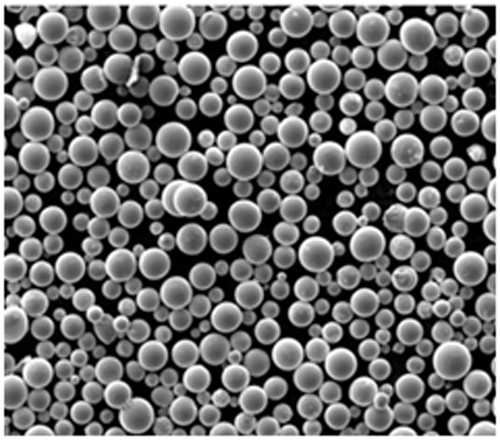
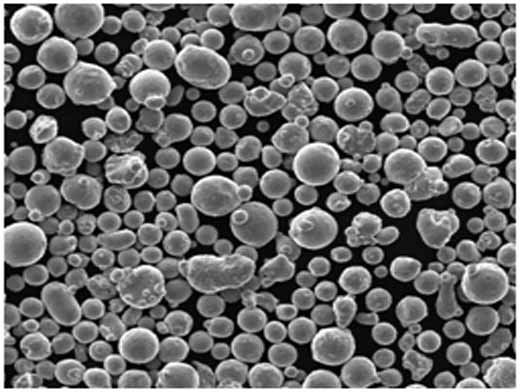


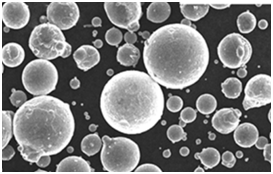
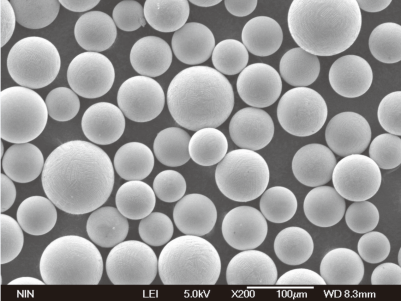
Spezifische Metallpulver-Modelle
Um Ihnen einen besseren Überblick über das Angebot auf dem Markt zu verschaffen, stellen wir Ihnen hier zehn spezifische Modelle von Sphärogusspulvern vor, die jeweils für bestimmte Anwendungen und Branchen konzipiert sind:
1. Sphärisches Pulver auf Fe-Basis
- Zusammensetzung: Hauptsächlich Eisen, mit Spuren von Kohlenstoff und anderen Legierungselementen.
- Eigenschaften: Hohe Festigkeit, gute Verschleißfestigkeit und thermische Stabilität.
- Anwendungen: Pulvermetallurgie, Automobilteile, Industriewerkzeuge.
2. AlSi10Mg Kugelförmiges Pulver
- Zusammensetzung: Aluminium mit 10% Silizium und 0,4% Magnesium.
- Eigenschaften: Geringes Gewicht, hervorragende Wärmeleitfähigkeit und gute mechanische Eigenschaften.
- Anwendungen: Luft- und Raumfahrt, Automobilindustrie und leichte Strukturbauteile.
3. Ti6Al4V Kugelförmiges Pulver
- Zusammensetzung: Titan, legiert mit 6% Aluminium und 4% Vanadium.
- Eigenschaften: Hohes Verhältnis von Festigkeit zu Gewicht, hervorragende Korrosionsbeständigkeit.
- Anwendungen: Luft- und Raumfahrt, medizinische Implantate, technische Hochleistungskomponenten.
4. sphärisches Pulver aus 316L-Edelstahl
- Zusammensetzung: Eisen, Chrom, Nickel und Molybdän.
- Eigenschaften: Korrosionsbeständig, gute mechanische Eigenschaften, biokompatibel.
- Anwendungen: Medizinische Geräte, Ausrüstung für die Lebensmittelverarbeitung, chemische Verarbeitung.
5. Inconel 718 Kugelförmiges Pulver
- Zusammensetzung: Superlegierung auf Nickelbasis mit Chrom, Niob und Molybdän.
- Eigenschaften: Ausgezeichnete Hochtemperaturfestigkeit, Oxidations- und Korrosionsbeständigkeit.
- Anwendungen: Luft- und Raumfahrt, Gasturbinen, Hochtemperaturanwendungen.
6. CuCrZr Kugelförmiges Pulver
- Zusammensetzung: Kupfer, legiert mit Chrom und Zirkonium.
- Eigenschaften: Hohe elektrische und thermische Leitfähigkeit, gute mechanische Eigenschaften.
- Anwendungen: Elektrische Komponenten, Wärmemanagement, Wärmetauscher.
7. Sphärisches CoCrMo-Pulver
- Zusammensetzung: Kobalt, Chrom und Molybdän.
- Eigenschaften: Ausgezeichnete Verschleißfestigkeit, biokompatibel, korrosionsbeständig.
- Anwendungen: Medizinische Implantate, Zahnprothetik, Schneidwerkzeuge.
8. Kugelförmiges Maraging-Stahlpulver
- Zusammensetzung: Eisen-Nickel-Legierung mit Kobalt, Molybdän und Titan.
- Eigenschaften: Hohe Festigkeit, gute Zähigkeit, Aushärtungsfähigkeit.
- Anwendungen: Luft- und Raumfahrt, Werkzeugbau, hochbeanspruchte Anwendungen.
9. AlSi12 Kugelförmiges Pulver
- Zusammensetzung: Aluminium mit 12% Silizium.
- Eigenschaften: Leichtes Gewicht, gute Korrosionsbeständigkeit, einfach zu gießen.
- Anwendungen: Komponenten für die Automobilindustrie, die Luft- und Raumfahrt und den allgemeinen Maschinenbau.
10. 17-4 PH Edelstahl Kugelförmiges Pulver
- Zusammensetzung: Eisen, Chrom, Nickel und Kupfer.
- Eigenschaften: Hohe Festigkeit, Korrosionsbeständigkeit, gute Schweißbarkeit.
- Anwendungen: Luft- und Raumfahrt, chemische Verarbeitung, Meeresumgebungen.
Jedes dieser Pulver wurde speziell entwickelt, um den Anforderungen der jeweiligen Anwendung gerecht zu werden, was die Vielseitigkeit und Anpassungsfähigkeit von kugelförmigen Pulvern in der modernen Fertigung verdeutlicht.
Vorteile des Sphärolysepulvers
Warum sollten Sie sich für kugelförmige Pulver entscheiden?
Sphäroidisierte Pulver bieten eine Reihe von Vorteilen, die sie von ihren unregelmäßigen Pendants abheben. Lassen Sie uns einige der wichtigsten Vorteile aufschlüsseln:
| Vorteil | Beschreibung |
|---|---|
| Verbesserte Fließfähigkeit | Die Kugelform ermöglicht bessere Fließeigenschaften, was bei Verfahren wie dem 3D-Druck entscheidend ist. |
| Höhere Packungsdichte | Die kugelförmigen Partikel liegen dichter beieinander, was die Dichte und die mechanischen Eigenschaften des Endprodukts verbessert. |
| Reduzierte Oxidation | Eine geringere Oberfläche verringert die Gefahr der Oxidation, was zu einer höheren Reinheit und einer besseren Qualität der Endprodukte führt. |
| Verbesserte thermische Stabilität | Kugelförmige Pulver sind bei hohen Temperaturen stabiler, was sie ideal für Anwendungen in extremen Umgebungen macht. |
| Bessere Oberflächenqualität | Glatte, kugelförmige Partikel erzeugen bessere Oberflächen in Beschichtungs- und Druckverfahren. |
| Gleichbleibende Qualität | Die einheitliche Form und Größenverteilung führt zu besser vorhersehbaren und wiederholbaren Ergebnissen über verschiedene Chargen hinweg. |
Diese Vorteile machen kugelförmige Pulver zu einer bevorzugten Wahl in Branchen, in denen Präzision, Leistung und Zuverlässigkeit an erster Stelle stehen.
Vergleich von Sphäro-Pulver mit herkömmlichen Metallpulvern
Kugelförmiges Pulver vs. unregelmäßiges Pulver
Bei der Auswahl des richtigen Pulvers für Ihre Anwendung ist es wichtig, die Unterschiede zwischen kugelförmigen und herkömmlichen unregelmäßigen Pulvern zu kennen. Hier ist ein Vergleich:
| Aspekt | Sphäroidisierungspulver | Traditionelles unregelmäßiges Puder |
|---|---|---|
| Form | kugelförmig, glatt | Unregelmäßige, unterschiedliche Formen |
| Fließfähigkeit | Ausgezeichnet | Mäßig bis schlecht, je nach Form und Größe |
| Packungsdichte | Hoch | Niedriger, aufgrund unregelmäßiger Formen |
| Oxidationsbeständigkeit | Besser, da geringere Oberfläche | Höheres Oxidationspotenzial, größere exponierte Oberfläche |
| Thermische Stabilität | Im Allgemeinen höher | Variiert je nach Zusammensetzung |
| Qualität der Oberflächenbehandlung | Überlegen, da gleichmäßige Partikelform | Geringer, aufgrund der gröberen Partikelmorphologie |
| Kosten | Im Allgemeinen höher aufgrund zusätzlicher Verarbeitung | Niedrigerer, einfacherer Produktionsprozess |
Kugelförmige Pulver sind zwar in der Regel teurer, aber ihre überlegene Leistung in Schlüsselbereichen rechtfertigt oft die zusätzlichen Kosten, insbesondere in der Hochpräzisionsindustrie.
Anwendungen von Sphäro-Pulver
Additive Fertigung (3D-Druck)
Eine der bekanntesten Anwendungen von kugelförmigen Pulvern ist die additive Fertigung, insbesondere der 3D-Druck von Metallen. Die hohe Fließfähigkeit und Packungsdichte dieser Pulver ermöglichen die präzise Ablagerung von Materialschichten, was für die Herstellung detaillierter und strukturell solider Bauteile entscheidend ist.
- Vorteile: Gleichmäßiger Materialfluss, verbesserte mechanische Eigenschaften und hervorragende Oberflächengüte.
- Branchen: Luft- und Raumfahrt, Automobilindustrie, medizinische Geräte.
Pulvermetallurgie
In der Pulvermetallurgie ist die Fähigkeit zur Herstellung dichter und fester Teile entscheidend. Kugelförmige Pulver bieten die notwendigen Eigenschaften, um diese Ziele durch Verdichtungs- und Sinterprozesse zu erreichen.
- Vorteile: Höhere Dichte, verbesserte mechanische Eigenschaften und gleichbleibende Qualität.
- Branchen: Automobilindustrie, Industriewerkzeuge, Maschinen.
Thermische Spritzschichten
Kugelförmige Pulver werden auch häufig in thermischen Spritzschichten verwendet, wo ihre Kugelform eine gleichmäßige Verteilung und eine starke Haftung auf dem Substrat gewährleistet.
- Vorteile: Verbesserte Verschleißfestigkeit, Korrosionsschutz und länger anhaltende Beschichtungen.
- Branchen: Luft- und Raumfahrt, Industriemaschinen, Marine.
Metall-Spritzgießen (MIM)
Beim Metall-Spritzgießen ist die Fließfähigkeit des Ausgangsmaterials entscheidend für die Herstellung komplexer Teile mit hoher Präzision. Kugelförmige Pulver bieten die hierfür erforderlichen Eigenschaften.
- Vorteile: Bessere Fließfähigkeit, höhere Teiledichte und bessere mechanische Eigenschaften.
- Branchen: Medizinische Geräte, Unterhaltungselektronik, Automobilindustrie.
Oberflächenbehandlung
Kugelförmige Pulver werden in Oberflächenbehandlungsverfahren eingesetzt, um die Verschleißfestigkeit, Härte und Korrosionsbeständigkeit von Bauteilen zu verbessern. Ihre kugelförmige Form gewährleistet eine gleichmäßige Beschichtung und verbessert die Gesamtleistung der behandelten Oberfläche.
- Vorteile: Verbesserte Haltbarkeit, längere Lebensdauer der Komponenten und höhere Leistung.
- Branchen: Industriemaschinen, Automobilindustrie, Luft- und Raumfahrt.
Spezifikationen und Normen für Sphärogusspulver
Wichtige Spezifikationen und Normen
Bei der Auswahl von Sphäroidisierungspulver für Ihre Anwendung ist es wichtig, die geltenden Spezifikationen und Normen zu berücksichtigen. In der folgenden Tabelle sind einige der wichtigsten Aspekte zusammengefasst:
| Spezifikation | Beschreibung |
|---|---|
| Partikelgrößenverteilung | Je nach den Anforderungen der Anwendung liegt sie in der Regel zwischen 15 und 150 Mikrometern. |
| Reinheit | Hoher Reinheitsgrad, oft 99 % oder höher, um Verunreinigungen und Mängel im Endprodukt zu minimieren. |
| Durchflussmenge | Wird in Sekunden für ein bestimmtes Volumen gemessen und gibt die Fähigkeit des Pulvers an, reibungslos zu fließen. |
| Scheinbare Dichte | Ein Maß dafür, wie dicht das Pulver verpackt ist, typischerweise höher bei kugelförmigen Pulvern. |
| Sphärizität | Ein Maß dafür, wie kugelförmig die Partikel sind, typischerweise nahe bei 1 für hochwertige Pulver. |
| Normen | Zu den gängigen Normen gehören ASTM, ISO und DIN, die Anforderungen an die Partikelgröße, Zusammensetzung und Qualität festlegen. |
Die Einhaltung dieser Spezifikationen gewährleistet, dass das von Ihnen gewählte Pulver die erforderlichen Leistungskriterien für Ihre spezifische Anwendung erfüllt.
Lieferanten und Preisgestaltung
Führende Anbieter und Preisangaben
Die Suche nach dem richtigen Lieferanten für Sphäroidisierungspulver ist entscheidend für eine gleichbleibende Qualität und eine zuverlässige Versorgung. Im Folgenden finden Sie eine Übersicht über einige der führenden Anbieter und deren Preise:
| Anbieter | Standort | Produktpalette | Preisgestaltung (ungefähr) | Bemerkenswerte Kunden |
|---|---|---|---|---|
| Sandvik Additive Fertigung | Schweden | Große Auswahl an Metallpulvern | $50 – $150/kg | Luft- und Raumfahrt, Medizin, Industrie |
| Hoganas AB | Schweden | Hochwertige Metallpulver | $40 – $120/kg | Automobilindustrie, Industrie, Elektronik |
| Tischlertechnik | USA | Speziallegierungspulver | $60 – $180/kg | Luft- und Raumfahrt, Energie, Industrie |
| AP&C (GE-Zusatzstoff) | Kanada | Pulver auf Titan- und Nickelbasis | $70 – $200/kg | Luft- und Raumfahrt, Medizintechnik, Automobilindustrie |
| LPW-Technik (Zimmerertechnik) | UK | AM-spezifische Pulver | $55 – $160/kg | Luft- und Raumfahrt, Medizin, Industrie |
Die Preisgestaltung kann je nach Faktoren wie Pulverzusammensetzung, Partikelgrößenverteilung und Auftragsvolumen variieren. Es ist immer eine gute Idee, Proben anzufordern und gründliche Tests durchzuführen, um sicherzustellen, dass das Pulver Ihren spezifischen Anforderungen entspricht.
Vor- und Nachteile von Sphäroidisierungspulver
Vorteile und Benachteiligungen
Kugelförmige Pulver bieten zwar viele Vorteile, sind aber auch nicht ohne Nachteile. Hier ist ein ausgewogener Blick auf die Vor- und Nachteile:
| Profis | Nachteile |
|---|---|
| Verbesserte Fließfähigkeit | Höhere Kosten: Der Sphäroidisierungsprozess erhöht die Gesamtkosten. |
| Höhere Packungsdichte | Komplexe Fertigung: Erfordert fortschrittliche Ausrüstung und Technologie. |
| Reduzierte Oxidation | Begrenzte Verfügbarkeit: Nicht alle Metalle lassen sich leicht kugelförmig machen. |
| Verbesserte Oberflächengüte | Potenzial für Kontamination: Die Handhabung muss sorgfältig gehandhabt werden, um Kontaminationen zu vermeiden. |
| Gleichbleibende Qualität | Längere Vorlaufzeiten: Bei kundenspezifischen Pulvern kann es zu längeren Produktionszeiten kommen. |
Die Kenntnis dieser Vor- und Nachteile kann Ihnen helfen, eine fundierte Entscheidung bei der Auswahl von Sphäroidisierungspulver für Ihr Projekt zu treffen.
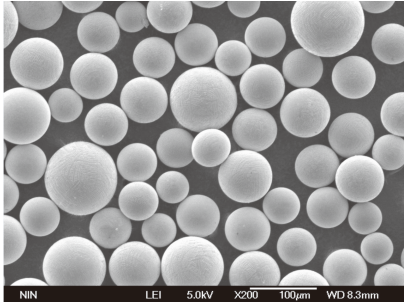
FAQ
| Frage | Antwort |
|---|---|
| Was ist Sphäroidisierungspulver? | Sphäroidisierungspulver ist eine Art von Metallpulver, das so bearbeitet wird, dass es eine kugelförmige Form erhält, um die Fließfähigkeit und die Packungsdichte zu verbessern. |
| Warum ist kugelförmiges Pulver besser? | Kugelförmige Pulver bieten im Vergleich zu unregelmäßigen Pulvern eine bessere Fließfähigkeit, eine höhere Packungsdichte, eine geringere Oxidation und eine bessere Oberflächenqualität. |
| Welche Industriezweige verwenden Sphärogusspulver? | Branchen wie die Luft- und Raumfahrt, die Automobilindustrie, die Medizintechnik und die industrielle Fertigung verwenden Sphäroidpulver für verschiedene Anwendungen. |
| Wie wird Sphärogusspulver hergestellt? | Kugelförmiges Pulver wird in der Regel durch Zerstäubung oder Wärmebehandlung hergestellt, bei der die Partikel in eine kugelförmige Form gebracht werden. |
| Was sind die wichtigsten Spezifikationen, die zu beachten sind? | Zu den wichtigsten Spezifikationen gehören Partikelgrößenverteilung, Reinheit, Fließgeschwindigkeit, Schüttdichte und Sphärizität. |
| Ist Sphäroidisierungspulver teurer? | Ja, sphäroidisierende Pulver sind in der Regel teurer, da eine zusätzliche Verarbeitung erforderlich ist, um ihre kugelförmige Form zu erreichen. |

